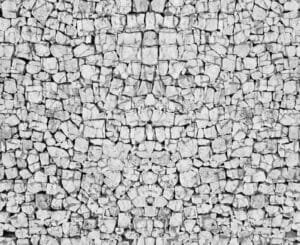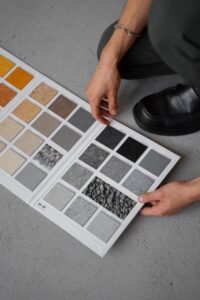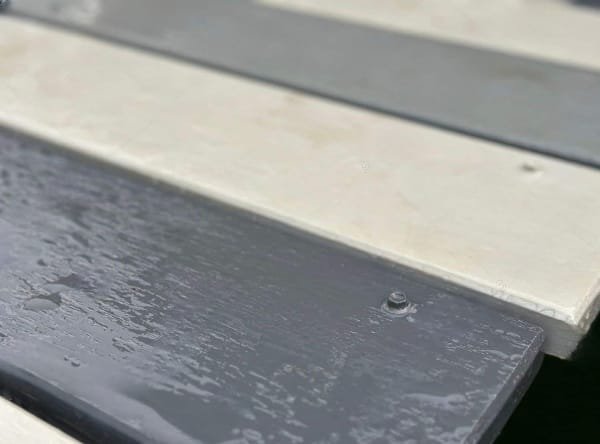Introduction to Smooth vs Rough Wall Texture
Wall textures play a pivotal role in the overall aesthetic and functional aspects of interior design. They not only enhance the visual appeal of a space but also contribute to the ambiance and mood. Depending on the chosen wall texture, a room can exude warmth or sophistication, making a significant impact on how occupants perceive and interact with their environment. One of the primary facets of wall textures is that they provide depth and character to otherwise flat surfaces, transitioning a standard room into a more engaging and inviting setting.
There are several types of wall textures available, each catering to different tastes and design philosophies. Common textures include smooth, rough, stucco, and raised patterns, each offering unique visual and tactile experiences. Smooth wall textures typically provide a clean and modern look, favoring simplicity and elegance. They are often paired with minimalist décor to maintain an uncluttered atmosphere. In contrast, rough wall textures can evoke a sense of rustic charm or organic warmth, easily attracting attention and creating a focal point in a room. Such textures also provide practical advantages; for example, they can help with sound absorption and offer better grip for wall-mounted fixtures.
Furthermore, the impact of wall textures extends to the perceived size and shape of spaces. Light can reflect differently on smooth surfaces compared to rough ones, influencing how spacious or cozy a room feels. The selection of a specific wall texture can thus transform the overall identity of a space, making it critical for designers and homeowners to consider their choices carefully. By selecting the right wall texture, one can effectively enhance ambiance, ensuring that it aligns with the desired mood and purpose of the interior environment.
Understanding Mithila Paints
Mithila Paints, rooted in the vibrant tradition of Mithila art, boasts a rich history that dates back centuries. Originating from the Mithila region of Bihar, India, this form of painting is characterized by intricate designs, bright colors, and deeply symbolic motifs. Mithila Paints seeks to encapsulate this artistic heritage and translate it into high-quality paint options that appeal to modern sensibilities while honoring traditional techniques.
The manufacturing process of Mithila Paints is a testament to its commitment to quality. The brand employs eco-friendly materials, ensuring that the paints are not only beautiful but also safe for both users and the environment. Each color is carefully crafted, drawing inspiration from the natural landscapes and cultural elements of the Mithila region. This dedication to authenticity ensures that each product reflects the artistry and vibrancy of the original Mithila paintings.
One of the distinguishing features of Mithila Paints is its extensive color palette, which is heavily influenced by the local flora, fauna, and traditional practices. The unique hues range from rich earth tones to vivid splashes of color, allowing homeowners to select shades that resonate with their personal style while echoing the aesthetics of Mithila art. Unlike many other paint brands, Mithila Paints offers a texture that enhances the visual and tactile experience of the painted surface, whether opting for smooth or rough wall textures.
The brand’s reputation for quality is not only attributed to its meticulous manufacturing process but also its commitment to customer satisfaction. Mithila Paints has garnered recognition for durability and ease of application, making it a preferred choice for both residential and commercial projects. As a result, Mithila Paints stands as a unique blend of tradition and modernity, offering artistic paint solutions that truly enliven spaces.

Advantages of Smooth Wall Textures
Smooth wall textures have gained popularity in interior design, primarily due to their numerous practical and aesthetic benefits. One of the foremost advantages of smooth textures is their ease of cleaning. Unlike rough textures that may trap dust and dirt, smooth walls can be wiped down effortlessly. This characteristic is particularly beneficial in high-traffic areas, such as living rooms and kitchens, where spills and stains are more likely to occur. Regular maintenance becomes less of a chore, thereby allowing homeowners to maintain a clean and inviting environment with minimal effort.
Another practical benefit of smooth wall textures is their durability. Smooth finishes typically feature high-quality products like Mithila paints that are designed to withstand wear over time. These paints often provide a protective layer, ensuring that the walls remain free from marks and fading, even in challenging conditions. As a result, smooth textures can be an economical choice, reducing the frequency of repainting compared to rougher alternatives that may show signs of wear more quickly.
From an aesthetic standpoint, smooth wall textures can significantly enhance the visual appeal of a space. Their sleek surface allows for excellent light reflection, which can brighten a room and create an illusion of more space. Smooth textures lend themselves well to contemporary design themes, embodying a modern and elegant look that many homeowners desire. Furthermore, they serve as a perfect backdrop for various decors styles, facilitating the integration of artwork and furniture pieces without distraction. Ultimately, smooth wall textures combine practicality and beauty, making them an ideal option for many living environments.

Advantages of Rough Wall Textures
Rough wall textures offer a range of benefits that can significantly enhance the aesthetic and practical features of a space. One of the most notable advantages is the character and warmth these textures contribute to an environment. Unlike smooth surfaces, rough textures introduce a tactile element that invites touch and interaction, thereby creating a more cozy and inviting atmosphere. This is particularly beneficial in areas designed for relaxation and socialization, such as living rooms and lounges.
Moreover, rough wall textures can effectively camouflage imperfections that may exist on the underlying wall surface. Cracks, uneven patches, or minor flaws become less conspicuous when a rough texture is applied, allowing homeowners to maintain a polished look without excessive wall preparation. This adaptability not only saves time and labor but also proves economical in reducing the need for repairs before painting or finishing work.
In addition to their practical benefits, rough wall textures also offer unique visual appeal. Each application of texture can be customized to reflect personal style, ranging from subtle variations to bold patterns that can become focal points in a room. The interplay of light and shadow across a rough surface can add depth and dimension, highlighting architectural features and enhancing overall room design.
Choosing rough wall textures gives homeowners the opportunity to personalize their spaces in a way that smooth finishes often cannot match. The natural beauty derived from these textures can imbue a home with warmth and a sense of individuality. Overall, the blend of aesthetic charm and practical advantages makes rough wall textures a compelling choice for those looking to enrich their living spaces.

Choosing the Right Texture for Your Space
When selecting a wall texture for your interior, understanding the unique characteristics and implications of both smooth and rough textures is crucial. Factors such as room size, lighting, and the intended purpose of the space play significant roles in determining the most suitable option. Smooth wall textures often project a sleek, modern finish that can make spaces appear larger and more open. This finish is particularly beneficial in smaller rooms, as it reflects light effectively, thereby enhancing brightness and the overall atmosphere.
On the other hand, rough wall textures bring warmth and depth, creating an inviting ambiance. These textures are ideal for larger areas or spaces designated for relaxation, such as living rooms or dining areas, where a cozier feel is desired. A textured surface can also be a strategic choice in spaces that require sound dampening, as rough walls can absorb sound waves better than their smooth counterparts.
Lighting should also be a major consideration when deciding between textures. Rooms with ample natural light may benefit from smooth textures that play off sunlight, adding elegance and sophistication. Conversely, rooms with limited light can be enhanced with rough textures that provide visual interest, making the space feel more dynamic even in quieter lighting conditions.
For homeowners looking to create a cohesive interior design, mixing and matching textures can be an exciting approach. For instance, a smooth finish in hallways can lead to a rough texture in adjacent sitting areas, thereby creating a beautiful transition between different spaces while serving distinct purposes. Ultimately, understanding how wall textures interact with your room’s characteristics will enable more informed decisions, ensuring that the final selection harmonizes with your vision and enhances the overall aesthetic.

Color Options Available in Mithila Paints
Mithila Paints offers a rich palette of color options that accommodate both smooth and rough wall textures, catering to diverse aesthetic preferences and design themes. The choice of color significantly influences the perception of wall texture, ultimately affecting the ambiance of a room. For instance, lighter shades such as pastels and soft neutrals tend to enhance the appearance of smooth surfaces, creating a sense of spaciousness and tranquility. Conversely, darker colors can add depth and character to rough textures, emphasizing the texture’s intricate details and providing a more dynamic visual experience.
In the realm of popular color trends, earthy tones such as terracotta and olive green have gained traction, providing a connection to nature while complementing both smooth and rough finishes. Additionally, vibrant hues, including royal blue and mustard yellow, can serve as statement colors, adding a bold contrast to more subdued tones. The integration of such colors into interior design can lead to a harmonious balance, where the wall texture is highlighted without overpowering the overall look.
Selecting complementary colors is integral to achieving a cohesive design scheme. A smooth wall finished in a soft blush color can be beautifully contrasted with deep navy accessories, while a rough texture adorned in charcoal gray can benefit from bright white accents. Utilizing color wheels and design tools can aid homeowners and designers alike in identifying suitable color pairings that enhance the features of Mithila Paints’ wall textures.
It is essential to consider the function and mood of the space when choosing color options. For instance, calming colors are ideal for bedrooms, whereas vibrant shades can invigorate living areas or creative spaces. The versatility and variety of colors available in Mithila Paints empower individuals to express their unique style, ensuring that the chosen texture and hue work harmoniously together to enhance the overall aesthetic of any room.

Application Techniques for Different Textures
When it comes to applying Mithila paints, understanding the specific techniques for both smooth and rough wall textures is essential for achieving the desired finish. The application process can vary significantly based on the texture, and each method requires specific tools and preparation steps.
For smooth wall textures, the first step is to ensure that the surface is clean and free from debris. Sanding the walls may be necessary to achieve an even surface. Tools such as rollers, brushes, and sprayers can be employed in this process. A high-quality roller is essential for uniform paint application, while a fine brush can be used for corners and edges. The use of a primer before painting is advisable to enhance paint adhesion and ensure a long-lasting finish.
On the other hand, applying paint to rough wall textures requires a more robust approach. The preparation steps are similar, but additional care must be taken to fill in any major cracks or holes. A thicker paint or a texture-specific paint can be used to accommodate the uneven surface. Tools such as a textured roller or a trowel may be needed to create the desired pattern. It is also beneficial to apply paint in sections to allow for better control over the texture and coverage, ensuring each area is thoroughly coated.
For homeowners considering a DIY project, patience is vital. Take your time with both the preparation and application process, as a rushed job can result in an unsatisfactory finish. Testing your technique on a small section of the wall before full application can help assess the outcome. Whether opting for a smooth or rough texture, following these application techniques can significantly enhance the overall appearance of your walls.

Maintenance and Care of Wall Textures
Maintaining wall textures is crucial for preserving their appearance and longevity, particularly when considering the options offered by Mithila Paints. Smooth and rough wall textures each have specific care requirements that should be understood to keep interiors looking pristine.
For smooth wall textures, cleaning is relatively straightforward. Simple dusting with a microfiber cloth is often sufficient for routine maintenance. For deeper cleaning, a damp cloth with a mild detergent can be used to remove fingerprints or smudges that may accumulate over time. Avoid abrasive cleaners or scrub pads, as they can damage the finish. Additionally, applying a protective coating can enhance durability and facilitate cleaning. Clear acrylic sealants or wax can provide an extra layer of protection against moisture and stains.
Conversely, rough wall textures demand a different approach. Due to their uneven surfaces, they are more prone to trapping dust and dirt. A vacuum with a brush attachment can effectively remove this debris. For stains or scuffs, it is advisable to use soft-bristle brushes along with soapy water. In cases where the stains are more persistent, a spray cleaner designed specifically for textured surfaces may be required. It is important to note that applying a protective layer can be more challenging on rough textures. While some sealants can be used, they may need to be applied with a different technique, ensuring that the product works into the crevices of the surface.
Common issues, such as scuffs or stains, can occur on both wall textures. Prompt attention to these problems will minimize further damage. Smooth walls are less likely to hide imperfections, so regular checks are advisable. On the other hand, rough textures may need more frequent inspections to catch issues, as they can blend into the texture more readily. Overall, understanding the specific maintenance needs of each texture will facilitate the preservation of aesthetic appeal and functionality of the walls in your spaces.

Conclusion: Making the Right Choice
Choosing between smooth and rough wall textures is a significant decision that can impact the overall aesthetics and feel of a living space. Throughout this blog post, we have explored the defining characteristics of both texture options, highlighting their unique advantages and potential drawbacks. Smooth textures present an elegant and modern face, often reflecting light in a way that can make small spaces appear larger. On the other hand, rough textures bring a sense of warmth and authenticity, evoking an earthy, natural ambiance that can be appealing in various design styles.
In making an informed choice, it is crucial for homeowners to evaluate their lifestyle and preferences. A household that frequently hosts gatherings may prefer the durability and easy maintenance of a smooth wall texture, while individuals seeking a cozy and inviting atmosphere might lean towards the charm of a rough texture. Additionally, personal design goals play a vital role in this decision. Whether aiming for a minimalist chic look or a rustic, eclectic feel, smooth and rough textures can significantly contribute to achieving these themes.
Mithila Paints offers an array of options that cater to both smooth and rough textures, ensuring that every homeowner can find a perfect match for their space. The unique quality of Mithila Paints not only enhances the visual appeal of walls but also lends a personalized touch to home decors. Ultimately, regardless of the choice between smooth and rough textures, selecting Mithila Paints guarantees a lasting, high-quality finish that resonates with style and durability. Making the right choice involves consideration of various factors, but with Mithila Paints, beauty and quality are assured.


